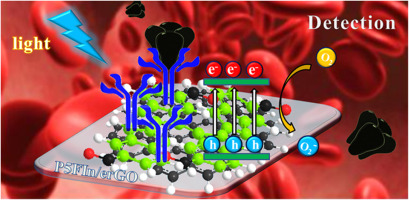Biosensors and Bioelectronics ( IF 10.7 ) Pub Date : 2018-05-25 , DOI: 10.1016/j.bios.2018.05.041 Guangming Nie , Yun Tang , Bin Zhang , Yang Wang , Qingfu Guo

|
Poly(5-formylindole)/electrochemically reduced graphene oxide (P5FIn/erGO) nanocomposite is firstly used to construct a label-free photoelectrochemical (PEC) immunosensor to detect carcinoembryonic antigen (CEA). As photoactive material and electroactive mediator, the prepared P5FIn/erGO nanocomposite exhibits high photocurrent intensity under visible-light irradiation due to the synergistic effect of P5FIn and erGO. The anti-CEA is connected to the P5FIn/erGO modified electrode surface, and gold nanoparticles (AuNP) is used as cross-linking in the process. The linear decrease of photocurrent is caused by the specific recognition of anti-CEA and CEA. This PEC immunosensor shows a wide linear response to CEA ranging from 0.0005 to 50 ng mL−1 with a low detection limit of 0.14 pg mL−1. The proposed immunosensor has good stability, reproducibility and high specificity. The satisfied results are also obtained when this immunosensor is used to detect CEA in actual human serum samples analysis, thus opening up a new promising PEC analysis platform based on conducting polymers.
中文翻译:

通过光敏导电聚(5-甲酰基吲哚)纳米复合材料检测癌胚抗原的无标记光电化学免疫传感平台
聚(5-甲酰基吲哚)/电化学还原氧化石墨烯(P5FIn / erGO)纳米复合材料首先用于构建无标记的光电化学(PEC)免疫传感器,以检测癌胚抗原(CEA)。制备的P5FIn / erGO纳米复合材料作为光敏材料和电活性介质,由于P5FIn和erGO的协同作用,在可见光照射下具有较高的光电流强度。抗CEA连接到P5FIn / erGO修饰的电极表面,并且金纳米颗粒(AuNP)在该过程中用作交联。光电流的线性下降是由抗CEA和CEA的特异性识别引起的。该PEC免疫传感器对CEA的线性响应范围从0.0005到50 ng mL -1不等,检测限低至0.14 pg mL -1。所提出的免疫传感器具有良好的稳定性,可再现性和高特异性。当这种免疫传感器用于实际人血清样品分析中的CEA检测时,也获得了满意的结果,从而开辟了一种基于导电聚合物的新的有前途的PEC分析平台。











































 京公网安备 11010802027423号
京公网安备 11010802027423号